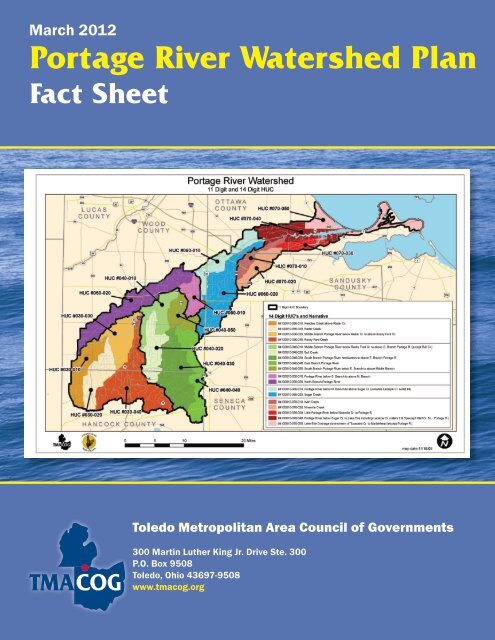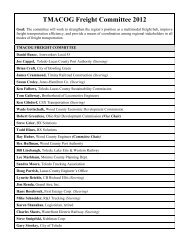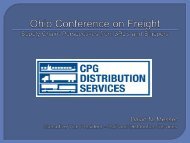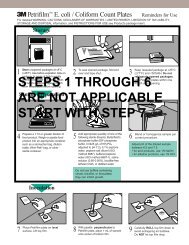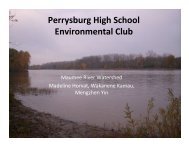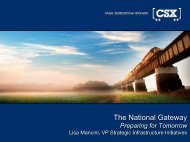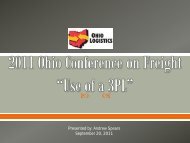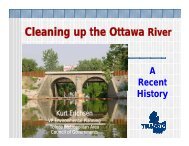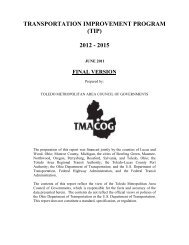Portage River Watershed Plan - Toledo Metropolitan Area Council of ...
Portage River Watershed Plan - Toledo Metropolitan Area Council of ...
Portage River Watershed Plan - Toledo Metropolitan Area Council of ...
You also want an ePaper? Increase the reach of your titles
YUMPU automatically turns print PDFs into web optimized ePapers that Google loves.
March 2012<br />
<strong>Portage</strong> <strong>River</strong> <strong>Watershed</strong> <strong>Plan</strong><br />
Fact Sheet<br />
<strong>Toledo</strong> <strong>Metropolitan</strong> <strong>Area</strong> <strong>Council</strong> <strong>of</strong> Governments<br />
300 Martin Luther King Jr. Drive Ste. 300<br />
P.O. Box 9508<br />
<strong>Toledo</strong>, Ohio 43697-9508<br />
www.tmacog.org
<strong>Portage</strong> <strong>River</strong> <strong>Watershed</strong> <strong>Plan</strong><br />
Fact Sheet<br />
<strong>Portage</strong> <strong>River</strong> Overview<br />
The <strong>Portage</strong> is one <strong>of</strong> northwest Ohio’s principal rivers. It drains part <strong>of</strong> the Great Black Swamp,<br />
which includes some <strong>of</strong> Ohio’s most productive farmland, and is home to 67,000 residents. The<br />
watershed covers parts <strong>of</strong> Hancock, Ottawa, Sandusky, Seneca, and Wood counties, the cities <strong>of</strong><br />
Bowling Green, Fostoria, and Port Clinton, and 25 villages. Three communities — McComb,<br />
North Baltimore, and Fostoria — draw their drinking water directly from the river or a tributary,<br />
and many others use its groundwater. The <strong>Portage</strong> provides water supply and water drainage,<br />
plus recreation for its residents and visitors.<br />
The mainstem <strong>of</strong> the river is over 60 miles long, and has several major tributaries: the North,<br />
Middle, South, and East Branches, Needles Creek, Rader Creek, Rocky Ford, Sugar Creek, Wolf<br />
Creek, and the Little <strong>Portage</strong>. The river flows generally northeasterly and enters Lake Erie at<br />
Port Clinton, with a total watershed area <strong>of</strong> 581 square miles.<br />
The <strong>Portage</strong> <strong>River</strong> Basin <strong>Council</strong><br />
In 1994 the <strong>Portage</strong> <strong>River</strong> Basin <strong>Council</strong> was created within TMACOG to preserve and restore<br />
the integrity <strong>of</strong> all waterways in the <strong>Portage</strong> <strong>River</strong> watershed. In that time, watershed<br />
stakeholders and TMACOG have worked together to address sewage treatment issues, repair<br />
malfunctioning septic systems, provide grant funding for agricultural conservation, and test<br />
water quality to teach students ecology.<br />
<strong>Portage</strong> <strong>River</strong> Water Quality<br />
In 2011 Ohio EPA completed the <strong>Portage</strong> <strong>River</strong> <strong>Watershed</strong> TMDL Report. The TMDL (total<br />
maximum daily load) specifies how much pollution must be reduced from various sources in<br />
order to meet Ohio’s water quality standards. The standards are based on uses <strong>of</strong> the waterway<br />
— for instance, recreation, drinking, or to support aquatic life. Measurement <strong>of</strong> water quality<br />
includes testing for bacteria, chemical content <strong>of</strong> the water, and the diversity <strong>of</strong> species living in<br />
a stream. A stream that meets water quality standards for recreation, drinking, or aquatic life is<br />
said to be “in attainment.” Where a stream does not meet standards, the TMDL identifies the<br />
reasons by listing “causes and sources <strong>of</strong> impairment.”<br />
Impairments may include a wastewater plant that doesn’t meet treatment standards, failed<br />
septic systems, stormwater run<strong>of</strong>f from urban areas or feedlots, fertilizer run<strong>of</strong>f from suburban<br />
gardens or farm fields, or loss <strong>of</strong> natural habitat along streams.<br />
The TMDL found all watersheds in attainment for drinking water, but places three on a watch<br />
list for nitrates. Of 49 sites tested for aquatic life, 27 (55%) were in attainment, 11 (22%) in<br />
partial attainment, and 11 (22%) in non‐attainment. Of 57 sites tested for recreation (i.e., fecal<br />
bacteria), 8 (14%) were in attainment and 49 (86%) were in non‐attainment. Three watersheds<br />
list fish tissue impairments (e.g., PCBs).<br />
<strong>Portage</strong> <strong>River</strong> <strong>Watershed</strong> <strong>Plan</strong> Fact Sheet 2
The TMDL tells us that parts <strong>of</strong> the <strong>Portage</strong> system have good water quality, especially larger<br />
streams <strong>of</strong> the Middle and South Branches, and Rocky Ford watersheds. The most widespread<br />
impairment is high fecal bacteria (E. coli) levels. Likely sources are failed septic systems or<br />
manure run<strong>of</strong>f. Municipal wastewater effluent, especially from combined sewer overflows, is<br />
another likely source. Common impairments for aquatic life are sedimentation, high levels <strong>of</strong><br />
nutrients (phosphorus and nitrogen), and lack <strong>of</strong> habitat.<br />
The <strong>Portage</strong> <strong>River</strong> and Lake Erie<br />
In recent years extensive blue‐green algae blooms have returned to Lake Erie. Algae raises<br />
water treatment costs, contributes toxins to the water, and discourages fishing, swimming, and<br />
tourism on the lake. While the algae blooms are not completely understood, it is clear that they<br />
are driven by high phosphorus levels. Nutrient loadings from the <strong>Portage</strong> and other Lake Erie<br />
streams are feeding the algae blooms. The <strong>Portage</strong> TMDL sets specific numerical targets for<br />
phosphorus load reductions needed for a clean Lake Erie. Phosphorus load reductions call for<br />
improvements <strong>of</strong> wastewater treatment plants, septic systems, manure management, and<br />
agricultural production through Best Management Practices.<br />
The <strong>Watershed</strong> <strong>Plan</strong><br />
From 2007 to 2011 TMACOG<br />
and <strong>Portage</strong> <strong>River</strong> Basin<br />
<strong>Council</strong> members prepared<br />
the <strong>Portage</strong> <strong>River</strong> <strong>Watershed</strong><br />
<strong>Plan</strong>. This plan provides a<br />
comprehensive inventory <strong>of</strong><br />
the physical, chemical, and<br />
biological health <strong>of</strong> the<br />
eighteen smaller watersheds<br />
<strong>of</strong> the river. The plan also<br />
recommends goals for 9 <strong>of</strong><br />
the 18 subwatersheds<br />
(referred to as “hydrological<br />
units” or HUCs). The goals<br />
are designed to achieve the<br />
phosphorus loading targets set by the TMDL, and are based on stakeholder input and target the<br />
areas having the greatest potential for restoration and protection.<br />
The <strong>Plan</strong> is being submitted to OEPA and ODNR with a request for their endorsement. A stateendorsed<br />
watershed plan supports, and in some cases is required for, state and federal grants.<br />
The following table summarizes the types <strong>of</strong> projects that the <strong>Portage</strong> <strong>River</strong> <strong>Watershed</strong> <strong>Plan</strong><br />
recommends. Specific projects are listed for the subwatersheds in Chapter 5 <strong>of</strong> the plan.<br />
<strong>Portage</strong> <strong>River</strong> <strong>Watershed</strong> <strong>Plan</strong> Fact Sheet 3
Water Quality<br />
Impairment<br />
High fecal bacteria (E. coli)<br />
levels<br />
Example Restoration Project<br />
Repair / replace malfunctioning or obsolete home sewage<br />
treatment systems (HSTS)<br />
Extend public sewers to eliminate HSTS<br />
Upgrade public sewerage systems<br />
Manure management practices to keep livestock run<strong>of</strong>f out <strong>of</strong><br />
streams<br />
Habitat alteration<br />
Sedimentation / siltation<br />
Protect and restore floodplains<br />
Agricultural buffer strips between a farm field and the stream<br />
Improve riparian habitat along streams<br />
Nutrient enrichment<br />
(nitrates, phosphates)<br />
Repair / replace malfunctioning or obsolete home sewage<br />
treatment systems (HSTS)<br />
Extend public sewers to eliminate HSTS<br />
Upgrade public sewerage systems<br />
Manure management practices to keep livestock run<strong>of</strong>f out <strong>of</strong><br />
streams<br />
Agricultural buffer strips between a farm field and the stream<br />
Improve riparian habitat along streams<br />
Cover crops for nutrient removal<br />
Controlled field drainage systems<br />
All<br />
Educational workshops and programs on best management<br />
practices for land owners, public <strong>of</strong>ficials, and stakeholders<br />
Implementation<br />
Implementation <strong>of</strong> projects related to public sewerage systems or household sewage treatment<br />
systems may be carried out under regulatory programs <strong>of</strong> county Health Departments or Ohio<br />
EPA. The <strong>Watershed</strong> <strong>Plan</strong> recommends that agricultural or habitat projects should be<br />
implemented on a voluntary basis with the willing support <strong>of</strong> the property owner. This plan<br />
supports financial incentives to carry out these projects.<br />
<strong>Portage</strong> <strong>River</strong> <strong>Watershed</strong> <strong>Plan</strong> Fact Sheet 4
Developing projects to carry out the plan will be the role <strong>of</strong> the <strong>Portage</strong> <strong>River</strong> Basin <strong>Council</strong>.<br />
Stakeholder involvement in the <strong>Council</strong> brings local resources that will make effective projects:<br />
ideas and local contacts, public outreach, data, and matching funds or in‐kind services for grant<br />
applications.<br />
Restoring water quality impairments in the <strong>Portage</strong> <strong>River</strong> watersheds will protect public health<br />
by reducing pathogens in the river, improve the river’s water quality, reduce nutrient loadings<br />
that result in toxic algae blooms in Lake Erie, protect the river’s natural beauty, and enhance<br />
recreation along the <strong>Portage</strong>.<br />
Resources<br />
Fact Sheet for the Ohio EPA <strong>Portage</strong> <strong>River</strong> <strong>Watershed</strong> TMDL<br />
http://www.epa.ohio.gov/portals/35/tmdl/<strong>Portage</strong>_FactSheet_Final.pdf<br />
TMACOG <strong>Portage</strong> <strong>River</strong> <strong>Watershed</strong> <strong>Plan</strong><br />
http://www.tmacog.org/Environment/<strong>Portage</strong>/2011/<strong>Portage</strong>_<strong>River</strong>_<strong>Watershed</strong>_<strong>Plan</strong>.pdf<br />
TMACOG <strong>Portage</strong> <strong>River</strong> <strong>Watershed</strong> <strong>Plan</strong> Appendices<br />
http://www.tmacog.org/Environment/<strong>Portage</strong>/2011/<strong>Portage</strong>_<strong>Watershed</strong>_<strong>Plan</strong>_Appendices.pdf<br />
Acknowledgements<br />
The <strong>Portage</strong> <strong>River</strong> <strong>Watershed</strong> <strong>Plan</strong> was prepared with the support and valuable assistance <strong>of</strong><br />
many state and federal agencies, local agencies <strong>of</strong> Hancock, Ottawa, Seneca, Sandusky, and<br />
Wood Counties, local jurisdictions, and watershed stakeholders. TMACOG is grateful for their<br />
contributions and dedication to environmental stewardship <strong>of</strong> the <strong>Portage</strong> <strong>River</strong>. The <strong>Portage</strong><br />
<strong>River</strong> <strong>Watershed</strong> <strong>Plan</strong> was funded by a grant from the Ohio Department <strong>of</strong> Natural Resources<br />
Division <strong>of</strong> Soil & Water Resources, and matching funds by members <strong>of</strong> TMACOG.<br />
<strong>Portage</strong> <strong>River</strong> <strong>Watershed</strong> <strong>Plan</strong> Fact Sheet 5


